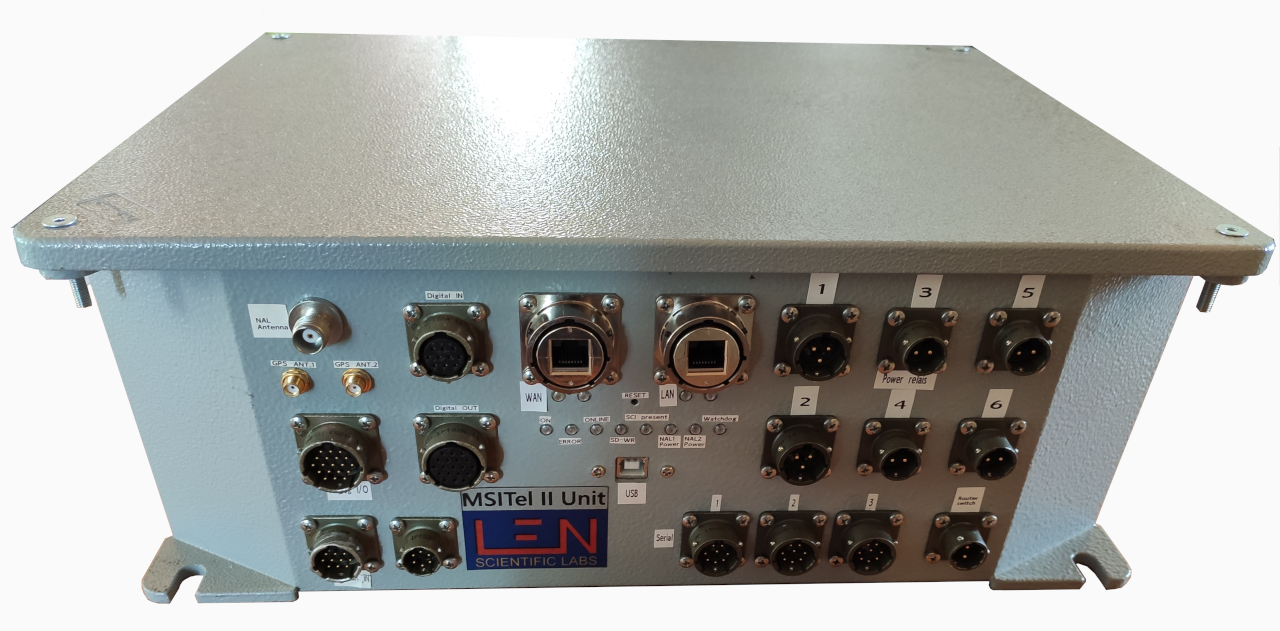
LEN has developed an integrated system to provide a telemetry and remote control link for Long Duration Balloon experiments. This product, built and tested using the Iridium satellite platform, is MSITel-II, which replaces the previous MSITel model (discontinued in 2021).
MSITel-II provides for acquiring scientific data via the Ethernet interface or from the three serial interfaces (RS232/RS485).
The accepted protocols are:
- On-demand (strongly recommended as more reliable)
- A burst with or without an end-of-package mark
- Continuous flow (the least reliable)
MSITel-II supports two types of output interfaces:
- Serial RS232 for connection to low-speed transceivers (up to two modems)
- Ethernet to satellite routers such as Iridium Pilot/Certus or others with speeds in the order of Mbit.
In addition, MSITel-II has RS232 /RS485 interfaces to interact with other housekeeping equipment or external remote control actuators.
Analogue and digital I/Os are available, and a particular class of output actuators, with safety protocols for uses such as pyrotechnic release, instrument activation or others (high-power and opto-isolated).
The MSITel-II protocols maintain good compatibility with previous versions of telemetry but provide new functionality and information.
All our telemetry runs a metalanguage created by the launcher and/or researcher for their needs, making our telemetry very flexible.
MSITel-II was validated in the Hemera ZPB 2022 launch campaign, using an Iridium Certus/Next terminal.
Technical specifications
- 10 to 40V external power supply from multiple sources
- Use of an internal battery (optional)
- Durable die-cast case
- MIL-type bayonet connectors (except GPS antenna connectors, NAL and RJ45 ports)
- Two professional GPS modules
- Two complete RS232 interfaces to handle Hayes modems with NAL modem power supply
- Data storage on microSD (up to two)
- USB console port to configure telemetry and check correct operation on the ground
- FastEthernet LAN port (for high-speed data download from scientific peripherals)
- FastEthernet WAN port (for high-speed satellite modem/router)
- Data handling and transmission of over 1Mbps
- Three serials that can operate either in RS232 or RS485 (software-selectable to be used for scientific data download or housekeeping up to 115200bps)
- One pressure sensor
- One humidity sensor
- One internal temperature sensor
- Three-axis accelerometer
- Eight digital inputs (CMOS tolerance)
- Eight opto-isolated outputs (max. 2A)
- Two analogue signal inputs (12bit resolution, up to 5Vdc). For higher voltages, an external divider and the new full-scale set in the telemetry configuration must be made
- Two 5Vdc full-scale analogue outputs
- Two inputs for external temperature sensors
- Six opto-isolated power outputs (up to 10A)
- One power switch up to 10A for modem/router power supply
MSITel (first version), STRADIUM and STRADIUM-II
MSITel was the first telemetry developed in the early 2000s in close collaboration with IASF Bologna. This telemetry was born to meet not only the needs of ‘experimenters’ but also as primary telemetry that could manage flying (ballast release, GPS localisation, pyrotechnic activation, …).
The main features are:
- It allows the simultaneous use of two satellite modems (typically Iridium NAL) reaching the maximum bandwidth of 4800bps (2400bps for NAL).
- Two-way, capable of transmitting to the ground and receiving appropriate commands or remote controls.
- Packet data transmission for easy identification.
- Direct channels for remote control actuators for release operations or external instrumentation activation.
- Automatic transmission of housekeeping information, such as position, temperature, pressure, etc.
- Transmission of ‘scientific’ channels with automatic retransmissions of unsent data due to transmission line failure.
- Acquisition of scientific data in various formats, continuous flow, packet, and on-demand.
- Acquisition of external on-demand housekeeping data (see power control system, modular, up to over 1 KW called SPSys).
- Storage of scientific data, housekeeping, logs on CF (Compact Flash).
- Redundancy and security on actuating remote controls.
- Modems can be selected in parallel or switched alternately as backups in case of need.
In a collaboration between ASI-LEN-IASF and others, in 2008 LEN produced a unit capable of handling multiple MSITels (up to 8) simultaneously to increase bandwidth. The MSITel array was called STRADIUM, tested in ASI (MILO base) in 2008, with a demonstration version of the complete system consisting of a “Splitter” unit, the heart of Stradium, and four MSITel units for a total of 8 Trancievers of the NAL Corporation.
In the meantime, LEN has produced significant improvements in MSITel’s firmware and the many ground procedures suitable for the profitable use of the product. ASI has defined, after the Sureca-Bit-10 mission, MSITel as the best telemetry currently available on the market.
This is precisely why other space agencies have decided to use MSITel for their stratospheric applications, either as primary or scientific telemetry (PoGOLite, SORA9, Sureca-Bit-10, etc.).
In 2016, ASI commissioned us to improve STRADIUM by creating an upgraded version (STRADIUM-II) that would allow higher bandwidth data transmission using a TCP/IP link.
To realize STRADIUM-II, we had to make a hardware interface (MSITel-IP) that converts the modem port of MSITel to FastEthernet, allowing data to be sent via TCP/IP. We also had to update the firmware of the telemetry and concentrator to add functionality and improve performance.
STRADIUM-II was used in the Olympus experiment launched from Svalbard in summer 2018.
On that occasion, the system consisted of:
- Two MSITel telemetries
- One concentrator (DataCollectorManager)
- Two Iridium NAL modems
- One Iridium Pilot unit